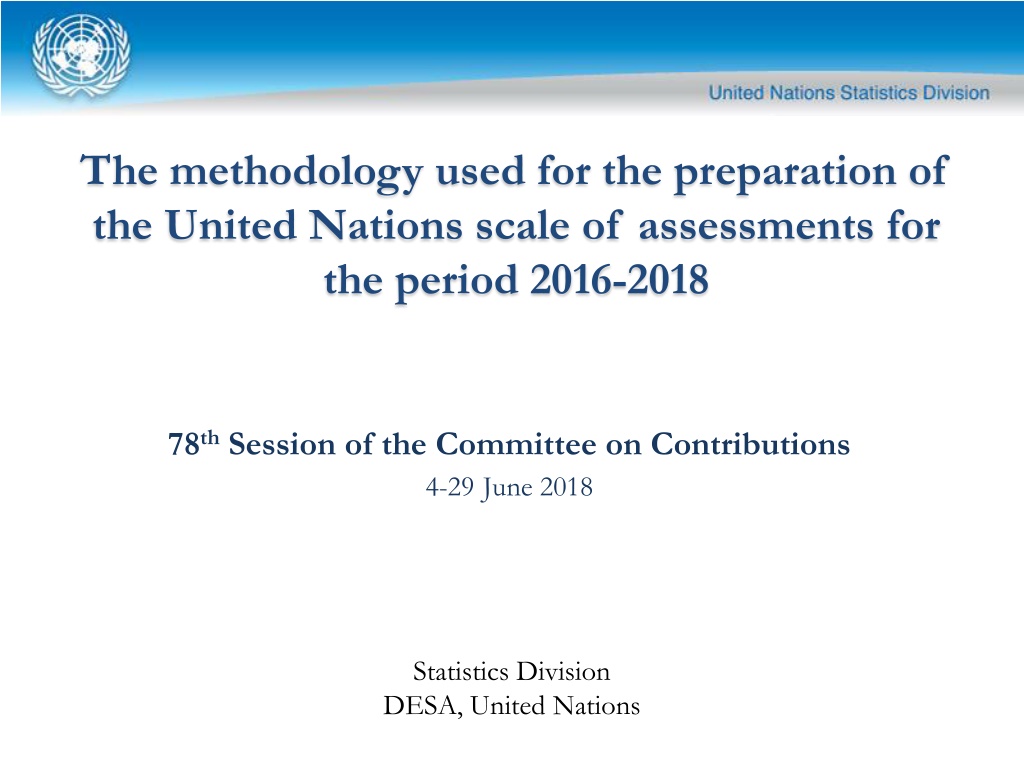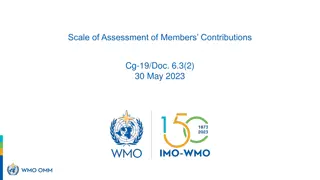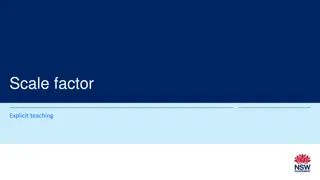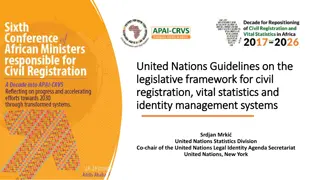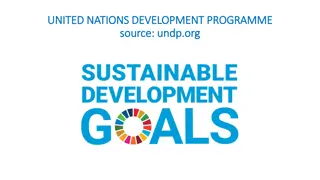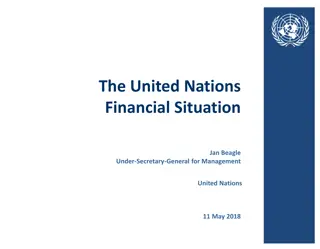Overview of United Nations' Scale of Assessments Methodology for 2016-2018 Period
The presentation provides an in-depth look into the methodology used by the United Nations to calculate the scale of assessments for Member States' contributions to the regular budget. It discusses key components such as national income, conversion rates, base periods, debt burden adjustments, relief measures, and more. The approach emphasizes reliability, verifiability, and comparability of data, as outlined by the Committee on Contributions for the 2016-2018 period.
Download Presentation

Please find below an Image/Link to download the presentation.
The content on the website is provided AS IS for your information and personal use only. It may not be sold, licensed, or shared on other websites without obtaining consent from the author. Download presentation by click this link. If you encounter any issues during the download, it is possible that the publisher has removed the file from their server.
E N D
Presentation Transcript
The methodology used for the preparation of the United Nations scale of assessments for the period 2016-2018 78thSession of the Committee on Contributions 4-29 June 2018 Statistics Division DESA, United Nations
Outline Introduction Main components of the methodology Data sources Step by step calculation - Example 2
Introduction The aim of this presentation is to provide an overview of the methodology for calculating the scale of assessments for the contribution of Member States to the regular budget of the United Nations. Article 17 of the Charter of the United Nations provides that Member States have the obligation to bear the expenses of the Organization, as apportioned by the General Assembly. The fundamental principle underlying the apportionment by the Assembly is based broadly on the capacity of Member States to pay, in accordance with rule 160 of its rules of procedure. 3
Introduction The General Assembly in resolution 70/245 (establishing the 2016-2018 scale) reaffirmed that the Committee on Contributions (CoC) as a technical body is required to prepare the scale of assessments strictly on the basisof reliable, verifiable and comparable data. The CoC (A/70/11, para. 21) noted the tradeoffs between timeliness, reliability, verifiability and comparability of the data. The methodology presented here is based on Annex II of the Report of the Committee on Contributions (A/70/11) and was used for the 2016-2018 scale calculations; same methodology that was used since the 2001-2003 scale. 4
Main components of the methodology In resolution 70/245, the GA determined the elements of the scale calculation for the 2016-2018 period. Three main components of the methodology: National Income Conversion rates Base period Two base periods: 3 and 6 years (1946) (1946) (1946) (2001) Comparative estimates of income Debt burden adjustment (1986) Low per capita income adjustment (1946) Relief Measures Floor LDC ceiling No increase for LDC (1983-1997) Ceiling 0.010 per cent Maximum ceiling (1946) (1983) Limits to scale (1998) (1946) 6
National income Income measure is the first approximation of the Member States (MS) capacity to pay. Gross National Income (GNI) is used as the income measure. The national income of an economy represents the income of its residents. It is obtained by adjusting the Gross Domestic Product (GDP) with the income of residents from activities abroad and the income of non- residents from activities in the country: GNI = GDP - primary incomes payable to non-resident units + primary incomes receivable from non-resident units 7
Exchange rates To establish a comparable measure of income, GNI in national currency is converted to United States dollars (US$) using market exchange rates (MERs). For MS for which no MERs are available, United Nations operational rates (UNOP) of exchange are used instead. When MERs cause excessive fluctuations and distortions in the GNI of a particular MS, MERs may be replaced with Price-adjusted rates of exchange (PARE) or other appropriate conversion rates. 8
Systematic criteria Member State Step 1 -Exchange rate has been fixed -pcGNI in US$ is unreasonable Yes No MER may be adjusted Step 2 pcGNI growth factor 1.5 times or 0.67 times world average pcGNI growth factor No Yes MER not adjusted Step 3 MER valuation index (MVI) 1.2 times or 0.8 times world average MVI Yes No MER may be adjusted MER not adjusted 9
Base period Final scale is calculated based on the arithmetic average of scales from the most recent three-year and a six-year base periods. Base periods for the adopted 2016-2018 scale Six-year base period 2008 2009 2010 2011 2012 2013 Three-year base period 2011 2012 2013 Each of the most recent three years receive 25 per cent of the total weight, and each of the remaining three years receive about 8.3 percent of the total weight. 10
Debt burden adjustment Debt burden adjustment (DBA) is an element of the methodology to relieve the impact of the repayment of external debt on the capacity to pay. The DBA is applied to MS with a per capita GNI below the World Bank threshold for high-income economies. Since interest payments are already accounted for in the GNI, only principal payments on external debt are deducted from GNI. Indirect redistribution: new GNI shares are based on the debt-adjusted GNI (GNIda ). 11
Debt burden adjustment DBA is based on a proportion of the total external debt stock of the MS concerned debt stock approach. It is assumed that external debt is repaid over a period of 8 years. 87.5% Total external debt stock 12.5% DBA: amount deducted from GNI 12
Low per capita income adjustment Income per head of population should be taken into account to prevent anomalous assessments based on comparative estimates of national income (A/70/11, para. 51). The Low per capita income adjustment (LPCIA) provides relief for MS based on per capita GNI (pcGNI). It consists of two parameters to set the size of the adjustment: the threshold to determines which MS benefit from the LPCIA (average pcGNI of all MS); the gradient (80 per cent). 13
Low per capita income adjustment LPCIA reduces the GNIda share of the affected MS by a factor that is based on the percentage that the pcGNIda is below the established LPCIA threshold, subject to the gradient: Calculate the percentage difference between the pcGNIda and the threshold. Multiply this percentage with the gradient of 80 per cent. Reduce the MS GNIda share with this percentage. Redistribution to MS above the threshold on a pro rata basis of their GNIda share. 14
Limits to scale Floor: The minimum assessment rate. Two ceilings: a) A ceiling limit for the Least Developed Countries (LDCs). b) A maximum ceiling. 15
Floor Floor is an element of the methodology since the outset. It changed from 0.010 to 0.001 per cent since the 1998-2000 scale. Floor: 0.001 per cent Scale The shares of MS below the floor are raised to 0.001 per cent. Redistribution of the adjustment is on a pro rata basis to MS above the floor. 16
Ceilings Ceilings are the maximum assessment rates. MS Maximum rate: 22 per cent. Maximum Ceiling 22.000 Scale LDCs Maximum assessment rate for LDCs: 0.010 per cent. LDC ceiling 0.010 Pro rata redistribution: LDC ceiling points are distributed to all MS except those at the floor; points at maximum ceiling are distributed to all MS except those at the floor and at the LDC ceiling. 17
Overview of the process Steps 7-9 Step 1 Steps 2-6 Step 10 Limits to the scale Machine scale for 3-year base period Income Measure Relief measures GNI in national currency Debt burden adjustment Floor Average of machine scales Conversion rates LDC ceiling Machine scale for 6-year base period LPCIA GNI in US dollars Maximum ceiling 18
Data Sources 19
Data Sources: National Income National Income Data are provided, in national currency, by MS to UNSD in response to the United Nations annual national accounts questionnaire. http://unstats.un.org/unsd/nationalaccount/madt.asp?SB=1&#SBG When data are not available from the MS, UNSD prepares estimates based on available information from other sources including: MS publications, UN regional commissions, the World Bank, and the IMF. 20
Data Sources: National Income UNSD disseminates the national accounts data in two separate databases: National Accounts Statistics, Main Aggregates and Detailed Tables (MADT) database, available at: http://data.un.org/Explorer.aspx?d=SNA National Accounts Statistics, Analysis of Main Aggregates (AMA) database, available at: http://unstats.un.org/unsd/snaama/Introduction.asp The data in national currency from the AMA database are used in the scale calculations. 21
Data Sources: Exchange rates Exchange rates Market exchange rates (MERs) from the IMF publication International Financial Statistics, available at: http://www.elibrary.imf.org/browse?freeFilter=false&pageSize=10&sort=datedescending&t_7 =urn%3ASeries%2F041 For non-members of IMF, there are no market exchange rates available and the rates used are average annual United Nations operational (UNOPs) rates of exchange, available at: http://treasury.un.org/operationalrates Exchange rates are used for the conversion of national currencies to United States dollars. 22
Data Sources: External debt data External debt data Data are obtained from the World Bank International Debt Statistics Database, available at: http://datatopics.worldbank.org/debt/ids/ The database covers members of and borrowers from the World Bank that have per capita GNI below the World Bank threshold for high-income economies, which was $12,746 in 2014. In addition to the 124 MS covered in the database, 2 other MS provided data through their Permanent Missions for the calculation of the adopted scale of 2016-2018. Total external debt stock data are used for the debt relief adjustment. 23
Data Sources: Population estimates Population estimates Data are obtained from the biennial publication: World Population Prospects prepared by the Population Division of the Department of Economic and Social Affairs. Further details on the methodology can be found at: http://esa.un.org/unpd/wpp Midyear estimates of total population are used to calculate per capita GNI (pcGNI). These estimates are supplemented, as required, by national estimates for countries and areas not included in the World Population Prospects. 24
Overview of the data preparation process for the 2016-2018 scale calculation Data relevant for the 2008-2013 base period are finalized GNI data available up to 2013 NA Questionnaire sent to MS Data validation 2014 2015 Jul Aug Sept Oct Nov Dec Jan Feb Mar Apr May Jun Jul Aug Sept Oct Nov Dec GA CoC Population data (July 2013) Calculation of the scale for the CoC Adoption of the 2016-2018 scale of assessment Debt data available up to 2013 Exchange rates available up to 2013 25
Step by step application of the scale methodology Example of Australia and Bangladesh using the six-year base period 2008-2013 26
Step by step application of the scale methodology Step 1: Comparable measure of national income GNI in national currency (NC) GNI in US$ National currency to US$ exchange rates 27
Step by step application of the scale methodology Step 1: World GNI in US$ The average world GNI for the six-year base period 2008 to 2013 is $68,476,935 million 28
Step by step application of the scale methodology Step 1: MS share in world GNI Australia $1,258,534 million (1.838%) Rest of the World $67,081,198 million (97.962%) Bangladesh $137,203 million (0.200%) 29
Step by step application of the scale methodology Step 2: Debt Burden Adjustment DBA calculation Member States World GNI $68,476,935 million 67 126 Debt adjusted world GNI $67,920,679 Member States subject to DBA Member States not subject to DBA 30
Step by step application of the scale methodology Step 2: Debt Burden Adjustment Shares after the DBA application GNI shares at step 1 Australia $1,258,534 million (1.838%) Australia $1,258,534 million (1.853%) Rest of the World $66,528,464 million (97.950%) Bangladesh $137,203 million (0.200%) Bangladesh $133,981 million (0.197%) 31
Step by step application of the scale methodology Step 3: LPCIA threshold $9,861 World population 6,944,493,803 World GNI $68,476,935 million LPCIA threshold per capita GNI 32
Step by step application of the scale methodology Step 4: Member State per capita debt adjusted GNI pcGNIda Member State GNIda Member State population 33
Step by step application of the scale methodology Step 5: Calculating LPCIA 2. That is multiplied by the gradient (since 1998-2000 scale: 80 per cent). Threshold (world average pcGNI) 1. The percentage difference by which the pcGNIda is below the threshold is calculated. 3. MS GNIda share is reduced by a corresponding percentage. MS pcGNIda 34
Step by step application of the scale methodology Step 6: Application of the LPCIA For each base period, the total LPCIA is reallocated pro-rata to MS whose average pcGNIdais above the threshold. For illustrative purposes, to demonstrate the outcomes with and without maximum ceiling rates, two tracks are calculated. Track 1 Track 2 Used for final scale Used for presentation purposes The ceiling MS does not absorb any points in this and the subsequent steps. The ceiling MS is part of the calculations and absorbs points, in this and the subsequent steps. This procedure allows for a slightly lower redistribution of the maximum ceiling adjustment and has been part of the methodology since the outset. 35
Step by step application of the scale methodology Step 6: Application of the LPCIA Track 1 Total shares before LPCIA Total shares: LPCIA redistribution After LPCIA* 10.166 23.069 15.089 23.069 15.089 51.676 25.255 61.841 51.676 Member States above the threshold Member States above the threshold Member States above the threshold Member States below the threshold Member States below the threshold Member States below the threshold Redistributed shares Ceiling Member State Ceiling Member State *excluding the ceiling Member State 36
Step by step application of the scale methodology Step 6: Shares at the LPCIA step Shares after LPCIA application Shares at the DBA step Australia 2.217% Australia 1.853% Rest of the World 97.243% Bangladesh 0.054% Bangladesh 0.197% 37
Step by step application of the scale methodology Step 7: Floor limit Shares before floor adjustments Floor adjustment Floor application 0.0148 0.0111 0.026 0.0111 76.919 76.904 76.904 Shares of other Member States Shares of Member States under the floor Shares of other Member States Shares of other Member States Shares of Member States under the floor Shares of Member States at the floor Share adjustments 38 The ceiling Member State does not take part in this step of the methodology
Step by step application of the scale methodology Step 7: Shares at the floor step Shares at the LPCIA step Shares after the floor application Australia 2.217% Australia 2.217% Rest of the World 97.729% Bangladesh 0.054% Bangladesh 0.054% 39
Step by step application of the scale methodology Step 8: LDC ceiling Adjustment: LDC ceiling Total share before LDC ceiling After LDC ceiling 0.149 0.080 0.229 0.080 76.675 76.824 76.675 Share of LDC Ceiling Member States Share of absorbers Share of LDC Ceiling Member States Share of absorbers Share of LDC Ceiling Member States Share of absorbers Share adjustment 40 The ceiling Member State, and the floor Member States do not take part in this step of the methodology
Step by step application of the scale methodology Step 8: Shares at the LDC ceiling After the LDC floor Shares at the floor step Shares after the LDC ceiling application Australia 2.217% Australia 2.221% Rest of the world 97.769% Bangladesh 0.010% Bangladesh 0.054% 41
Step by step application of the scale methodology Step 8: Maximum ceiling step Ceiling application Adjustment: ceiling Shares before the ceiling adjustment 1.069 0.080 0.080 0.080 0.026 0.026 0.026 23.069 22.000 22.000 76.825 76.825 77.894 Share of the ceiling Member State Share of the ceiling Member State Share of the ceiling Member State Share of absorbers Share of absorbers Share of absorbers Share of floor Member States Share of floor Member States Share of floor Member States Share of LDC Ceiling Member States Share of LDC Ceiling Member States Share of LDC Ceiling Member States Share adjustment The floor Member States and the LDC ceiling Member States do not take part in this step of the methodology
Step by step application of the scale methodology Step 9: Shares at the maximum ceiling step Shares at the LDC ceiling step Shares after the maximum ceiling application Australia 2.221% Australia 2.252% Rest of the world 97.738% Bangladesh 0.010% Bangladesh 0.010% 43
Step by step application of the scale methodology Step 10: Final Step 6 year base period 3 year base period Final Scale Australia 2.252% Australia 2.421 % Australia 2.337 % 2 Bangladesh 0.010% Bangladesh 0.010% Bangladesh 0.010% 44
Thank You 45
